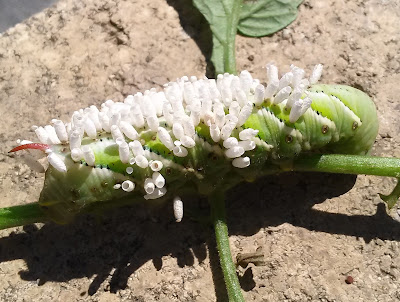What is it Wednesday
Can
you identify what's in this photo?
Each Wednesday morning
on Camp Lutherlyn's Facebook page
the Lutherlyn Environmental
Education Program posts a photo.
Readers
have all morning and afternoon
to
make their best guess about what the photo is.
Around
6 pm LEEP provides the answer and a brief explanation.
Each
week's What is it Wednesday post
will
also be posted on the Nature of Lutherlyn blog,
after it is posted on Facebook,
sometimes
with additional bonus information.
In
addition to bringing you current editions of What is it Wednesday
on the
Nature of Lutherlyn blog,
we
will be reposting old editions,
creating
a What is it Wednesday archive.
This photo was posted as a What is it Wednesday
sometime in 2017 - probably August.
And
the answer is....
This is a tomato hornworm caterpillar, covered with parasitic wasp pupae!
Tomato hornworms are a terrible garden pest that can grow to 4-5 inches long and decimate a tomato patch, leaving large round gouges in the tomatoes they have eaten. If you find a tomato hornworm in your garden, kill it!
But if you find a tomato hornworm in your garden that has white ovals on its back, keep it. Those ovals are the pupae of a parasitic wasp which kills tomato hornworms. Keeping them helps the wasp population, which controls the tomato hornworm population.
Like and follow Camp Lutherlyn on
Facebook, to see What is it Wednesday posts when
they come out and have the opportunity to share your guesses in the comments!



No comments:
Post a Comment